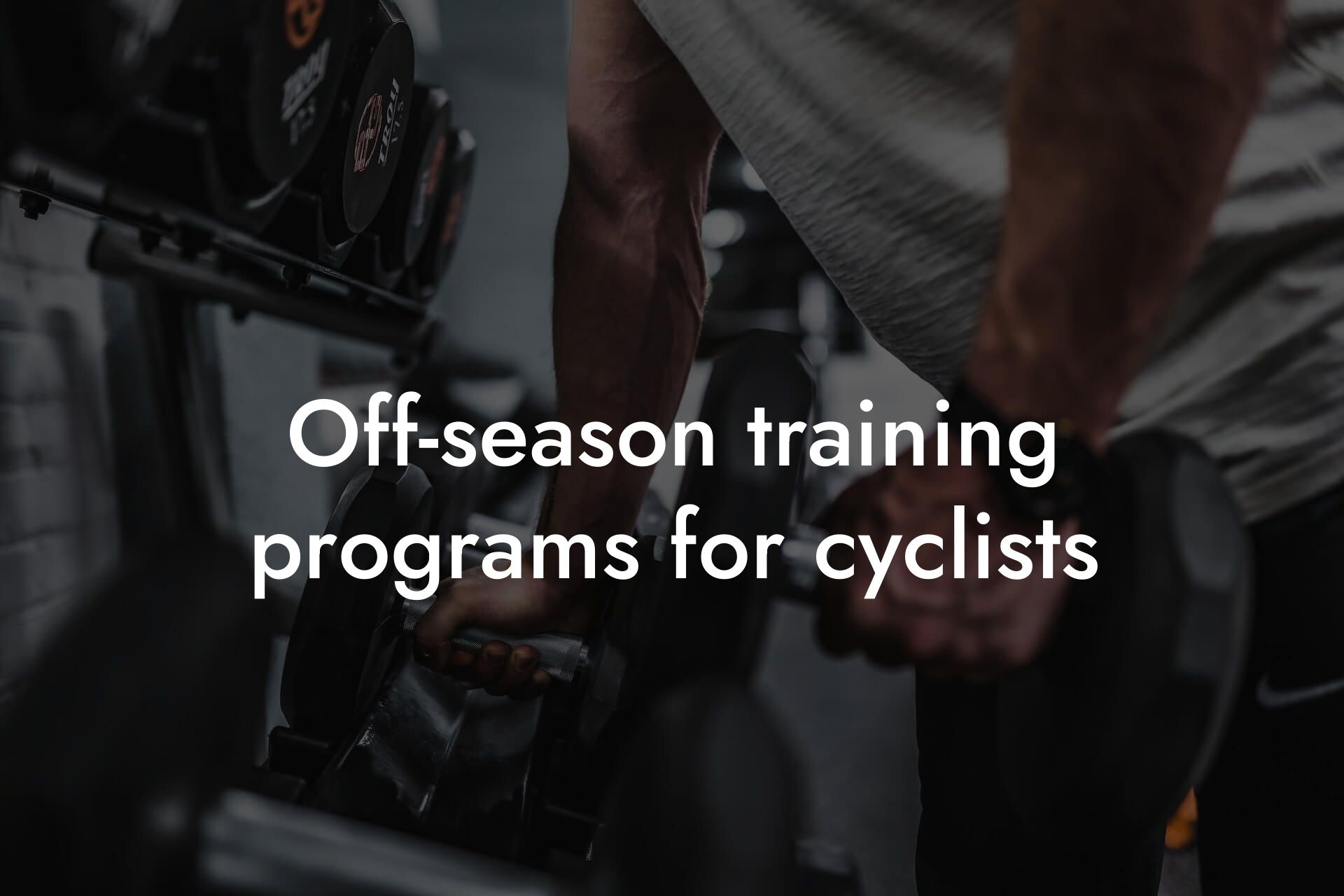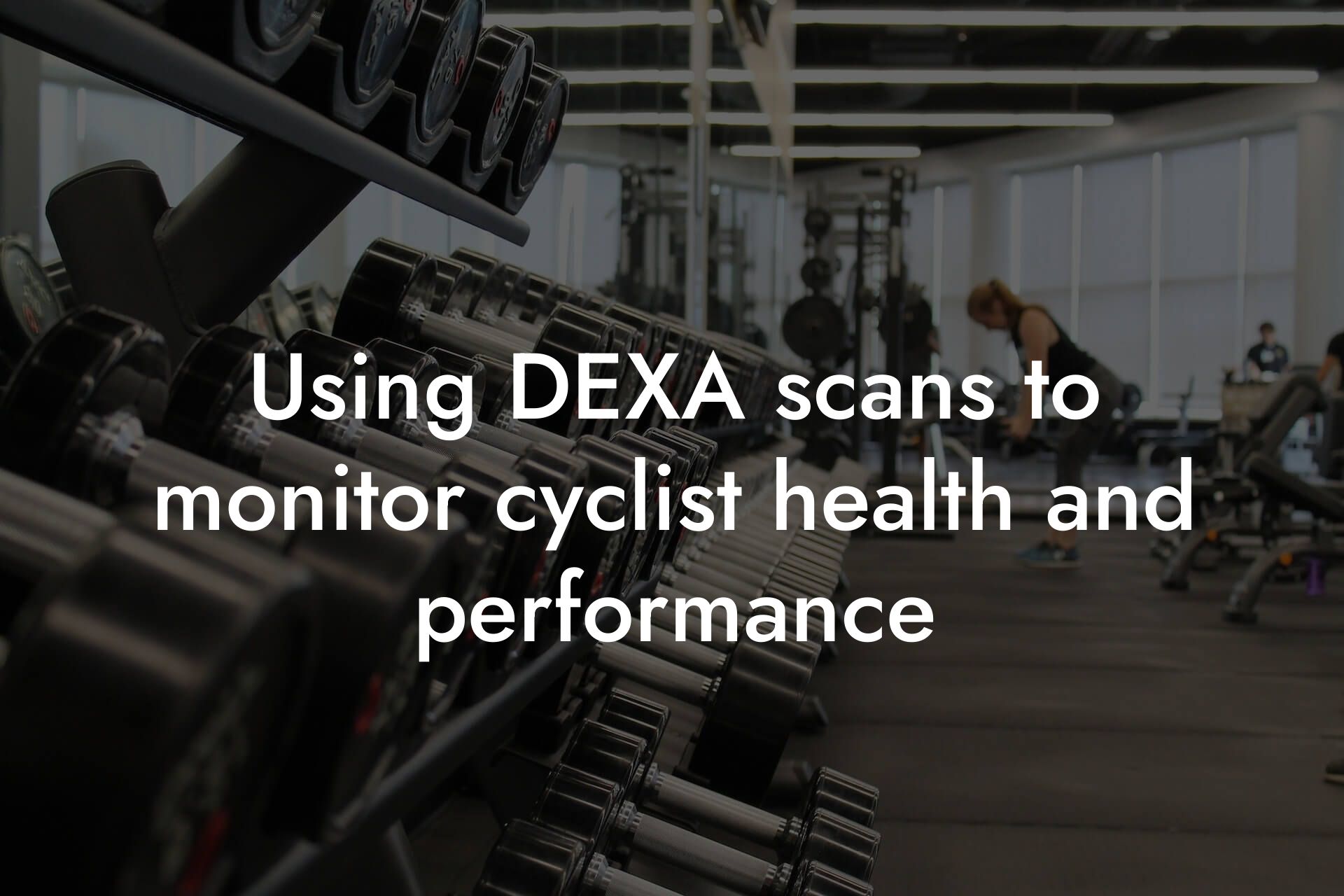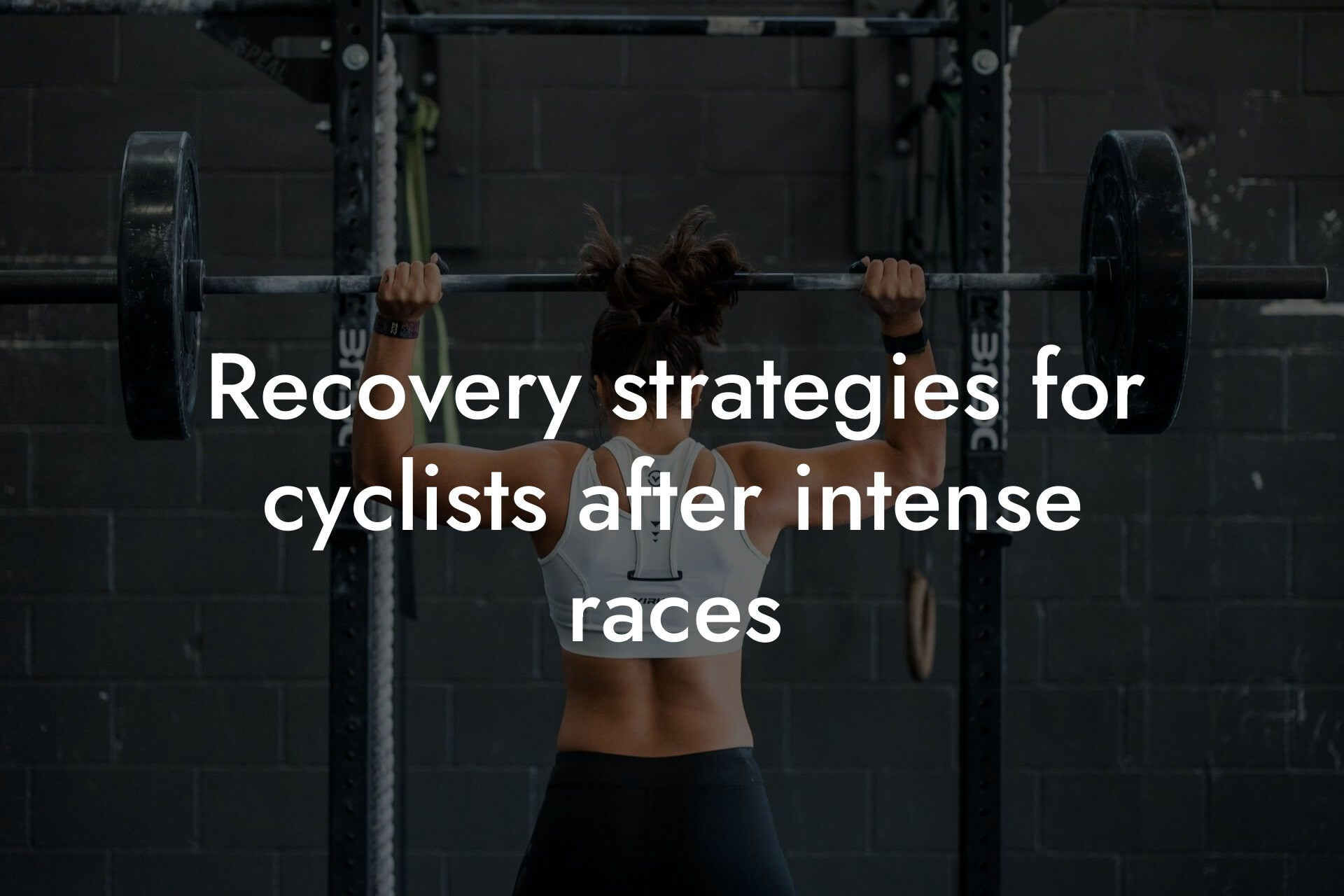As a cyclist, you're likely no stranger to the risks of injury that come with the sport. From road rash to broken bones, the impact of a crash or fall can be devastating. However, one often overlooked aspect of injury prevention is bone density. At Tano Performance Group, we understand the importance of maintaining strong bones to support your active lifestyle. In this article, we'll delve into the world of bone density and explore how it affects cyclists, as well as provide actionable tips for improving bone health and reducing the risk of injury.
Table of Contents
What is Bone Density?
Bone density refers to the measure of how dense and strong your bones are. It's an important indicator of overall bone health, as low bone density can increase the risk of fractures and osteoporosis. Bone density is typically measured using a DEXA (Dual-Energy X-ray Absorptiometry) scan, which uses X-rays to measure bone mineral density. This non-invasive test provides a detailed picture of bone health, allowing cyclists to take proactive steps to improve their bone density and reduce the risk of injury.
Why is Bone Density Important for Cyclists?
Cycling is a low-impact sport, but it can still take a toll on the bones. Prolonged periods of cycling can lead to bone loss, particularly in the hips, spine, and legs. This is because cycling is a non-weight-bearing activity, which means that the bones aren't subjected to the same level of stress and impact as they would be during high-impact activities like running or jumping. As a result, cyclists may experience a decline in bone density over time, increasing their risk of fractures and osteoporosis.
The Risks of Low Bone Density for Cyclists
Low bone density can have serious consequences for cyclists. A fracture or break can mean weeks or even months off the bike, which can be devastating for competitive cyclists or those who rely on cycling for transportation. Furthermore, low bone density can increase the risk of osteoporosis, a condition characterized by brittle and porous bones. Osteoporosis can lead to a range of health problems, including chronic pain, limited mobility, and increased risk of falls.
How to Improve Bone Density as a Cyclist
The good news is that bone density can be improved with a combination of diet, exercise, and lifestyle changes. Here are some tips specifically for cyclists:
-
Incorporate strength training: In addition to cycling, incorporate strength training exercises that target the hips, legs, and core. This can include squats, lunges, deadlifts, and leg press.
-
Eat a bone-healthy diet: Focus on consuming calcium-rich foods like dairy, leafy greens, and fortified plant-based milk. Vitamin D is also essential for bone health, so ensure you're getting enough through sun exposure, supplements, or fortified foods.
-
Incorporate high-impact activities: While cycling is low-impact, incorporating high-impact activities like running, jumping, or hiking can help stimulate bone growth and density.
-
Get enough sleep: Adequate sleep is essential for bone health, as it's during sleep that our bodies repair and rebuild bone tissue. Aim for 7-9 hours of sleep per night.
-
Reduce caffeine and alcohol intake: Both caffeine and alcohol can interfere with calcium absorption and bone health. Limit your intake of these substances to promote healthy bones.
DEXA Scans for Cyclists
At Tano Performance Group, we offer comprehensive DEXA scans to help cyclists understand their bone health. Our state-of-the-art DEXA machine provides a detailed picture of bone density, allowing cyclists to identify areas for improvement and track progress over time. By incorporating DEXA scans into your training regimen, you can:
-
Identify areas of low bone density and take proactive steps to improve bone health
-
Track changes in bone density over time, ensuring that your training and nutrition plan is effective
-
Optimize your training and nutrition plan to support bone health and reduce the risk of injury
Common Injuries in Cycling and How to Prevent Them
While bone density is an important aspect of injury prevention, it's not the only factor. Here are some common injuries in cycling and tips on how to prevent them:
-
Collarbone fractures: Wear a properly fitting helmet and ensure your bike is in good working condition to reduce the risk of falls.
-
Wrist and hand injuries: Wear padded gloves and consider adding ergonomic grips to your handlebars to reduce pressure on the wrists and hands.
-
Knee injuries: Incorporate strengthening exercises for the knees, such as squats and lunges, and ensure your bike is properly fitted to your body.
Bone density is a critical aspect of injury prevention for cyclists. By understanding the risks of low bone density and taking proactive steps to improve bone health, cyclists can reduce their risk of injury and maintain a healthy, active lifestyle. At Tano Performance Group, we're dedicated to helping cyclists achieve their goals through comprehensive DEXA scans and personalized coaching. Take control of your bone health today and ride with confidence.
Frequently Asked Questions
What is bone density, and why is it important for cyclists?
Bone density refers to the measure of how dense and strong your bones are. As a cyclist, maintaining healthy bone density is crucial because it helps prevent fractures and osteoporosis, which can be debilitating and even career-ending. Strong bones can also improve your overall athletic performance and reduce your risk of injury.
What are the risk factors for low bone density in cyclists?
Risk factors for low bone density in cyclists include a sedentary lifestyle, inadequate nutrition, hormonal imbalances, and a family history of osteoporosis. Additionally, cyclists who are underweight or have a history of eating disorders may also be at risk. It's essential to address these factors early on to prevent bone loss and promote overall bone health.
How does cycling affect bone density?
Cycling can have both positive and negative effects on bone density. On the one hand, cycling can help improve bone density in the legs and hips due to the repetitive loading and stress on these areas. However, cycling can also lead to bone loss in the spine and hips due to the prolonged periods of sitting and lack of weight-bearing activity.
What are the common injuries associated with low bone density in cyclists?
Cyclists with low bone density are more susceptible to injuries such as stress fractures, vertebral compression fractures, and osteoporotic fractures. These injuries can be severe and may require extended periods of rest and rehabilitation, which can be detrimental to a cyclist's performance and career.
How can I prevent bone loss as a cyclist?
To prevent bone loss, cyclists should engage in regular weight-bearing activities such as running, jumping, or weightlifting in addition to their cycling routine. A well-balanced diet rich in calcium and vitamin D is also essential for maintaining healthy bones. Furthermore, cyclists should avoid smoking and excessive alcohol consumption, which can negatively impact bone health.
What is the role of nutrition in maintaining healthy bone density?
Nutrition plays a critical role in maintaining healthy bone density. A diet rich in calcium, vitamin D, and other essential nutrients such as magnesium, potassium, and vitamin K can help promote bone growth and density. Cyclists should aim to consume a balanced diet that includes foods such as dairy products, leafy greens, and fortified cereals.
Can I take supplements to improve my bone density?
While supplements can be beneficial, it's essential to consult with a healthcare professional or registered dietitian before adding any supplements to your regimen. Calcium and vitamin D supplements may be recommended for cyclists who are deficient in these nutrients, but it's crucial to ensure that you're getting the right dosage and type of supplement for your specific needs.
How often should I get my bone density tested?
The frequency of bone density testing depends on several factors, including your age, medical history, and risk factors for osteoporosis. As a general rule, cyclists over the age of 30 should consider getting a baseline bone density test, and then repeat the test every 2-3 years to monitor any changes.
What is the relationship between body fat and bone density?
There is a complex relationship between body fat and bone density. While having some body fat is essential for bone health, excessive body fat can increase the risk of osteoporosis and fractures. Cyclists should aim to maintain a healthy body fat percentage through a balanced diet and regular exercise.
How does menopause affect bone density in female cyclists?
Menopause can lead to a rapid decline in bone density in female cyclists due to the decrease in estrogen levels. Female cyclists going through menopause should take extra precautions to maintain healthy bone density, including engaging in regular weight-bearing activities, taking calcium and vitamin D supplements, and getting regular bone density tests.
What are the benefits of strength training for bone density in cyclists?
Strength training can help improve bone density in cyclists by stimulating bone growth and increasing muscle mass. This can be especially beneficial for cyclists who are at risk of osteoporosis or have a history of fractures. A well-designed strength training program can also improve overall athletic performance and reduce the risk of injury.
Can I improve my bone density through cycling alone?
While cycling can help improve bone density in the legs and hips, it may not be enough to improve overall bone density. Cyclists should incorporate other forms of exercise, such as weight-bearing activities and strength training, into their routine to promote healthy bone density.
How does age affect bone density in cyclists?
Age is a significant risk factor for low bone density in cyclists. As we age, our bone density naturally declines, which can increase the risk of osteoporosis and fractures. Cyclists should take proactive steps to maintain healthy bone density as they age, including regular exercise, a balanced diet, and regular bone density tests.
What are the consequences of ignoring low bone density in cyclists?
Ignoring low bone density can have severe consequences for cyclists, including an increased risk of fractures, osteoporosis, and long-term disability. Cyclists who ignore their bone health may also experience a decline in athletic performance and a reduced quality of life.
How can I incorporate weight-bearing activities into my cycling routine?
Incorporating weight-bearing activities into your cycling routine can be simple and effective. Try adding activities such as running, jumping, or hiking to your routine 2-3 times a week. You can also incorporate strength training exercises that target your core, legs, and hips.
What is the role of hormones in maintaining healthy bone density?
Hormones, such as estrogen and testosterone, play a crucial role in maintaining healthy bone density. Hormonal imbalances can lead to bone loss and an increased risk of osteoporosis. Cyclists should consult with a healthcare professional if they have any concerns about hormonal imbalances and bone health.
Can I improve my bone density through stretching and flexibility exercises?
While stretching and flexibility exercises are essential for overall athletic performance, they may not have a significant impact on bone density. Cyclists should focus on weight-bearing activities and strength training to improve bone density.
How does bone density affect my overall athletic performance?
Bone density can have a significant impact on overall athletic performance. Strong bones can improve power, speed, and endurance, while weak bones can increase the risk of injury and reduce athletic performance.
What are the benefits of cross-training for bone density in cyclists?
Cross-training can be beneficial for bone density in cyclists by providing a varied range of exercises that target different muscle groups and bones. This can help improve overall bone density and reduce the risk of overuse injuries.
Can I use technology, such as wearables, to track my bone density?
While wearables and other technologies can track certain health metrics, they are not yet able to accurately track bone density. Cyclists should rely on regular bone density tests and consultations with healthcare professionals to monitor their bone health.
How does stress affect bone density in cyclists?
Chronic stress can have a negative impact on bone density in cyclists by increasing the production of cortisol, a hormone that can lead to bone loss. Cyclists should engage in stress-reducing activities, such as yoga or meditation, to help manage stress and promote healthy bone density.
What are the benefits of working with a healthcare professional to improve bone density?
Working with a healthcare professional can be beneficial for cyclists who want to improve their bone density. A healthcare professional can provide personalized guidance on nutrition, exercise, and supplementation, as well as monitor bone density and provide early detection of any potential issues.
Here are some related articles you might love...
- Off-season training programs for cyclists
- Using DEXA scans to monitor cyclist health and performance
- Recovery strategies for cyclists after intense races
- Nutrition tips for endurance during long cycling races
- Strength training for cyclists to improve power output
- The importance of body composition in cycling performance
- Reducing body fat for better power-to-weight ratio in cycling
- The role of muscle mass in cycling endurance
- Hydration and nutrition for optimal cycling performance
Zak Faulkner
Zak Faulkner is a leading authority in the realm of physical health and body composition analysis, with over 15 years of experience helping professionals optimise their fitness and well-being. As one the experts behind Tano Performance Group, Zak has dedicated his career to providing in-depth, science-backed insights that empower clients to elevate their physical performance and overall health.
With extensive knowledge of DEXA technology, Zak specializes in delivering comprehensive body assessments that offer precise data on body fat, muscle mass, bone density, and overall physique. His expertise enables individuals to make informed decisions and achieve their fitness goals with accuracy and confidence. Zak’s approach is rooted in a deep understanding of human physiology, combined with a passion for helping clients unlock their full potential through personalised strategies.
Over the years, Zak has earned a reputation for his commitment to excellence, precision, and client-focused service. His guidance is trusted by top professionals who demand the best when it comes to their health. Whether advising on fitness programs, nutritional strategies, or long-term wellness plans, Zak Faulkner’s insights are a valuable resource for anyone serious about taking their health and fitness to the next level.
At Tano Performance Group, Zak continues to lead our Content Team revolutionising how professionals approach their physical health, offering unparalleled expertise that drives real results.




